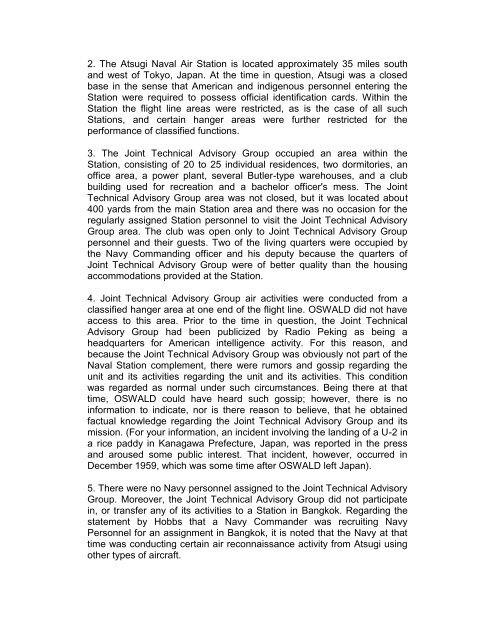NODULE X7 OSWALD IN MINSK AND THE U2 DUMP: JANUARY ...
NODULE X7 OSWALD IN MINSK AND THE U2 DUMP: JANUARY ...
NODULE X7 OSWALD IN MINSK AND THE U2 DUMP: JANUARY ...
You also want an ePaper? Increase the reach of your titles
YUMPU automatically turns print PDFs into web optimized ePapers that Google loves.
2. The Atsugi Naval Air Station is located approximately 35 miles south<br />
and west of Tokyo, Japan. At the time in question, Atsugi was a closed<br />
base in the sense that American and indigenous personnel entering the<br />
Station were required to possess official identification cards. Within the<br />
Station the flight line areas were restricted, as is the case of all such<br />
Stations, and certain hanger areas were further restricted for the<br />
performance of classified functions.<br />
3. The Joint Technical Advisory Group occupied an area within the<br />
Station, consisting of 20 to 25 individual residences, two dormitories, an<br />
office area, a power plant, several Butler-type warehouses, and a club<br />
building used for recreation and a bachelor officer's mess. The Joint<br />
Technical Advisory Group area was not closed, but it was located about<br />
400 yards from the main Station area and there was no occasion for the<br />
regularly assigned Station personnel to visit the Joint Technical Advisory<br />
Group area. The club was open only to Joint Technical Advisory Group<br />
personnel and their guests. Two of the living quarters were occupied by<br />
the Navy Commanding officer and his deputy because the quarters of<br />
Joint Technical Advisory Group were of better quality than the housing<br />
accommodations provided at the Station.<br />
4. Joint Technical Advisory Group air activities were conducted from a<br />
classified hanger area at one end of the flight line. <strong>OSWALD</strong> did not have<br />
access to this area. Prior to the time in question, the Joint Technical<br />
Advisory Group had been publicized by Radio Peking as being a<br />
headquarters for American intelligence activity. For this reason, and<br />
because the Joint Technical Advisory Group was obviously not part of the<br />
Naval Station complement, there were rumors and gossip regarding the<br />
unit and its activities regarding the unit and its activities. This condition<br />
was regarded as normal under such circumstances. Being there at that<br />
time, <strong>OSWALD</strong> could have heard such gossip; however, there is no<br />
information to indicate, nor is there reason to believe, that he obtained<br />
factual knowledge regarding the Joint Technical Advisory Group and its<br />
mission. (For your information, an incident involving the landing of a U-2 in<br />
a rice paddy in Kanagawa Prefecture, Japan, was reported in the press<br />
and aroused some public interest. That incident, however, occurred in<br />
December 1959, which was some time after <strong>OSWALD</strong> left Japan).<br />
5. There were no Navy personnel assigned to the Joint Technical Advisory<br />
Group. Moreover, the Joint Technical Advisory Group did not participate<br />
in, or transfer any of its activities to a Station in Bangkok. Regarding the<br />
statement by Hobbs that a Navy Commander was recruiting Navy<br />
Personnel for an assignment in Bangkok, it is noted that the Navy at that<br />
time was conducting certain air reconnaissance activity from Atsugi using<br />
other types of aircraft.


